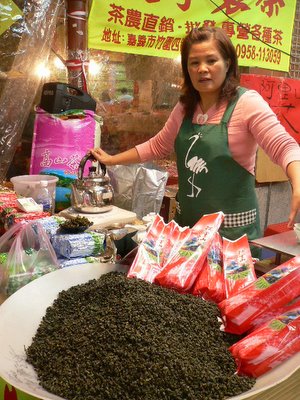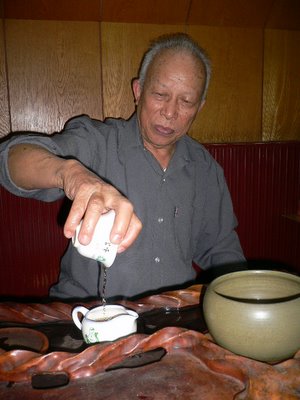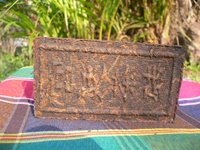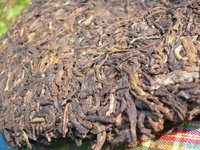
This news came as a shock to me! It means that all modern zhuni teapots are fake, doesn't it? Even my 2 round zhuni teapots? I have made a thorough investigation in the last 36 hours and here are my results.
1. Date of 'relative' extinction.
A first (
very lengthy, interesting, but sometimes incorrect article) dates the extinction in the 1970s. A more precise date of 1973 is confirmed
here (in Chinese). That's the year when the main mine for zhuni clay got extinct. I write main, because zhuni clay can still be found, albeit in very small quantity, in other Yixing red clay mines. Besides, the extinction is only relative for several reasons:
- like for most natural resources, it's impossible to tell for sure how much and where there is some left in the ground. With luck, or funds for wide scale exploration, a new zhuni mine may be discovered one day. So far, with other clays available and cheap, there is not enough financial incentive to invest in digging for new zhuni mines.
- some potters still have inventories of zhuni clay dating back to before 1973, when zhuni was mined in big quantities.
2. Buyers beware
This means that over 90% of modern zhuni teapots currently on the market are fake. Such teapots are made with a mix of red clay, zisha clay and/or other hard stones. Some unscrupulous business people even add chemicals to the clay. This practice, unfortunately, is not limited to the copying of zhuni but of any kind of yixing teapot.
3. How to distinguish a zhuni from a red clay teapot?
Teaparker showed us the
characteristics of a zhuni: under the surface, it's like there is some sand. It becomes even more apparent when the teapot is warm. This explanation also fits the name zhu-ni, which means red-sand. Let's notice that the name is not zhu-sha (like in zisha, purple sand). Ni refers to bigger sand like in Nitu (cement), while sha refers to smaller sand like baisha (in white sand beach).
4. Are my teapots of real, pure zhuni?
Yes, they are. My Taiwanese potter had been cooperating with the former State owned Yixing factory for some time, and 15 years ago approximately he bought a big inventory of zhuni clay from that factory. So far, he has used up half this original clay. He guarantees they are real and would compensate 10 times the value of one teapot if he were proven wrong, he told me as I was asking the tough questions.
If, like me, you don't want to take his word but want a second opinion from a reliable expert, let's turn to
Teaparker. From his website, you can see that he is not very much into selling tea or teaware. Almost all his focus is on writing books about the world of Chinese gongfu cha. I'm his student and probably a little bit biased in his favor, but it's a fact that he enjoys a high standing in Taiwan's tea world. Just last Saturday,
Ma Ying Jeou, the popular mayor of Taipei, Chairman of the KMT party, took part in a tasting of wild pu-erh with Teaparker.

With all his knowledge and experience, Teaparker confirms that these teapots are made of pure zhuni clay. He even goes as far as putting the
logo of his website, which is the name of the non profit tea association he chairs ("Cha Jen Ya Hsin") on one of the teapots (see picture). Hereby, Teaparker is committing what is most valuable to him: his reputation. If this were a fake and he couldn't tell, his reputation would be trashed. However, since his usage of this teapot shows him that he gets the same results as with his old zhuni, he is able to endorse a rare modern zhuni teapot that makes very fragrant tea and is still affordable.
5. Is the teapot created by a renowned Master?
No. Otherwise, the price would easily be 10 times higher. This potter has decided to apply his brand name under the teapot. The chop of the skilled and experienced craftsman who made the pot is placed under the cover. His philosophy is to make good teapots that are simply aimed at brewing tea as well as possible.
6. Why didn't he tell they how rare zhuni clay is?
Teaparker often warns us when a tea or some teaware comes with a story. This is usually just sales talk aimed at increasing the price. Since the extinction is not widely known among consumers, the potter doesn't want to use the rarity of zhuni to promote these teapots. More important than the 'story' is the function of his zhuni teapots: they make very fragrant oolong and puerh because zhuni is harder and less porous than zisha.
7. Why do I tell you then?
The principle of my blog is transparency and advanced gongfu cha knowledge. I write down and share what I learn and discover in the Chinese tea world. Some of you may have heard about it elsewhere, so it was important to clarify this issue.
 A Shou La Pei teapot and lots of cups.
A Shou La Pei teapot and lots of cups.





















































